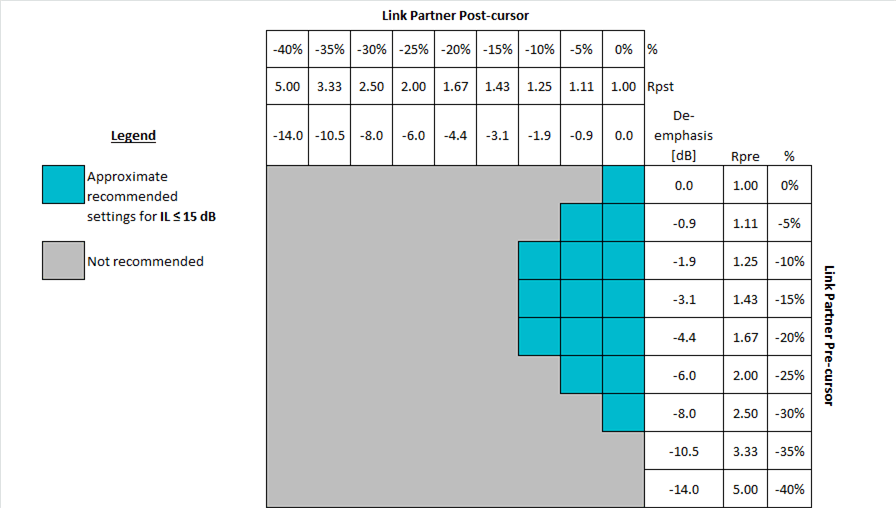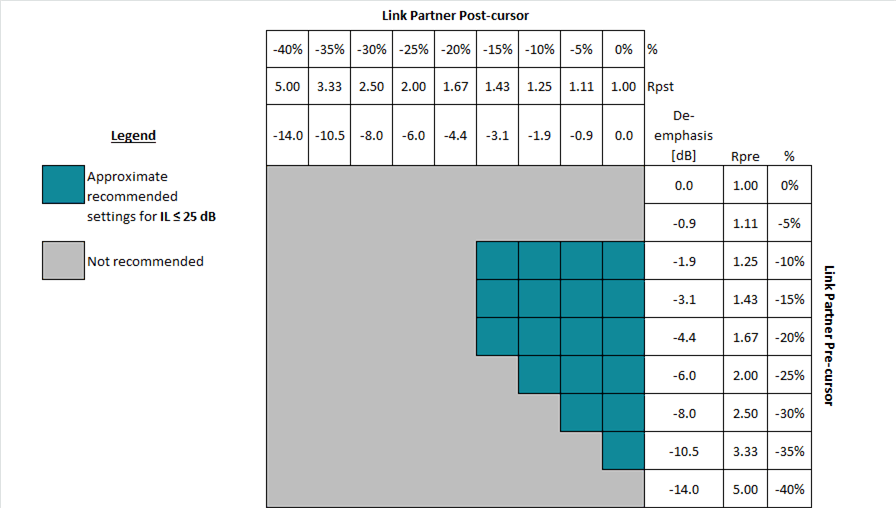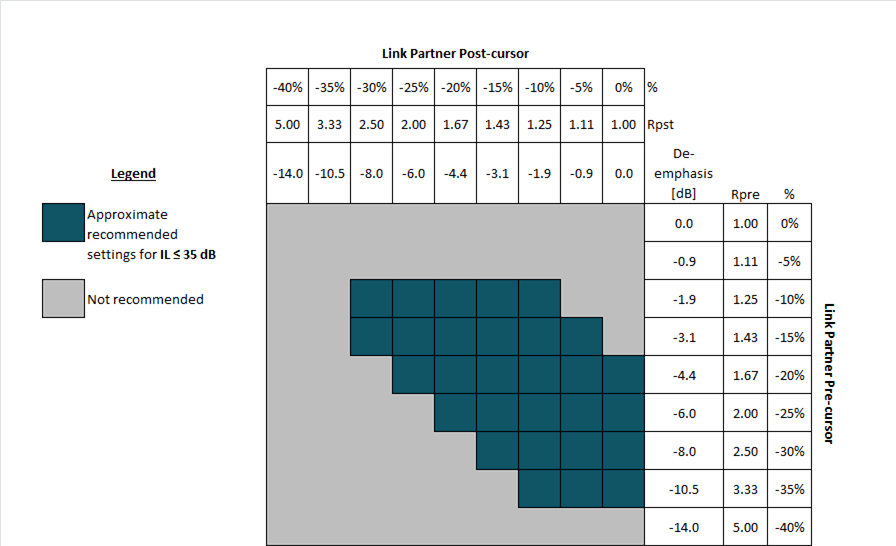ZHCSKE8D March 2016 – October 2019 DS250DF410
PRODUCTION DATA.
- 1 特性
- 2 应用
- 3 说明
- 4 修订历史记录
- 5 说明 (续)
- 6 Pin Configuration and Functions
-
7 Specifications
- 7.1 Absolute Maximum Ratings
- 7.2 ESD Ratings
- 7.3 Recommended Operating Conditions
- 7.4 Thermal Information
- 7.5 Electrical Characteristics
- 7.6 Timing Requirements, Retimer Jitter Specifications
- 7.7 Timing Requirements, Retimer Specifications
- 7.8 Timing Requirements, Recommended Calibration Clock Specifications
- 7.9 Recommended SMBus Switching Characteristics (Slave Mode)
- 7.10 Recommended SMBus Switching Characteristics (Master Mode)
- 7.11 Recommended JTAG Switching Characteristics
- 7.12 Typical Characteristics
-
8 Detailed Description
- 8.1 Overview
- 8.2 Functional Block Diagram
- 8.3
Feature Description
- 8.3.1 Device Data Path Operation
- 8.3.2 Signal Detect
- 8.3.3 Continuous Time Linear Equalizer (CTLE)
- 8.3.4 Variable Gain Amplifier (VGA)
- 8.3.5 Cross-Point Switch
- 8.3.6 Decision Feedback Equalizer (DFE)
- 8.3.7 Clock and Data Recovery (CDR)
- 8.3.8 Calibration Clock
- 8.3.9 Differential Driver with FIR Filter
- 8.3.10 Debug Features
- 8.3.11 Interrupt Signals
- 8.3.12 JTAG Boundary Scan
- 8.4 Device Functional Modes
- 8.5 Programming
- 8.6 Register Maps
- 9 Application and Implementation
- 10Power Supply Recommendations
- 11Layout
- 12器件和文档支持
- 13机械、封装和可订购信息
8.3.9.1 Setting the Output VOD, Pre-Cursor, and Post-Cursor Equalization
The output differential voltage (VOD), pre-cursor, and post-cursor equalization of the driver is controlled by manipulating the FIR tap settings. The main cursor tap is the primary knob for amplitude adjustment. The pre- and post-cursor FIR tap settings can then be adjusted to provide equalization. To maintain a constant peak-to-peak VOD, the user should adjust the main cursor tap value relative to the pre- and post-cursor tap changes so as to maintain a constant absolute sum of the FIR tap values. The table below shows various settings for VOD settings ranging from 205 mVpp to 1225 mVpp (typical). Note that the output peak-to-peak amplitude is a function of the sum of the absolute values of the taps, whereas the low-frequency amplitude is purely a function of the main-cursor value.
Table 2. Typical VOD and FIR Values
| FIR SETTINGS | Peak-to Peak VOD(V) | RPRE(dB) | RPST(dB) | ||
|---|---|---|---|---|---|
| PRE-CURSOR:
REG_0x3E[6:0] |
MAIN-CURSOR:
REG_0x3D[6:0] |
POST-CURSOR:
REG_0x3F[6:0] |
|||
| 0 | 0 | 0 | 0.205 | NA | NA |
| 0 | +1 | 0 | 0.260 | NA | NA |
| 0 | +2 | 0 | 0.305 | NA | NA |
| 0 | +3 | 0 | 0.355 | NA | NA |
| 0 | +4 | 0 | 0.395 | NA | NA |
| 0 | +5 | 0 | 0.440 | NA | NA |
| 0 | +6 | 0 | 0.490 | NA | NA |
| 0 | +7 | 0 | 0.525 | NA | NA |
| 0 | +8 | 0 | 0.565 | NA | NA |
| 0 | +9 | 0 | 0.610 | NA | NA |
| 0 | +10 | 0 | 0.650 | NA | NA |
| 0 | +11 | 0 | 0.685 | NA | NA |
| 0 | +12 | 0 | 0.720 | NA | NA |
| 0 | +13 | 0 | 0.760 | NA | NA |
| 0 | +14 | 0 | 0.790 | NA | NA |
| 0 | +15 | 0 | 0.825 | NA | NA |
| 0 | +16 | 0 | 0.860 | NA | NA |
| 0 | +17 | 0 | 0.890 | NA | NA |
| 0 | +18 | 0 | 0.925 | NA | NA |
| 0 | +19 | 0 | 0.960 | NA | NA |
| 0 | +20 | 0 | 0.985 | NA | NA |
| 0 | +21 | 0 | 1.010 | NA | NA |
| 0 | +22 | 0 | 1.040 | NA | NA |
| 0 | +23 | 0 | 1.075 | NA | NA |
| 0 | +24 | 0 | 1.095 | NA | NA |
| 0 | +25 | 0 | 1.125 | NA | NA |
| 0 | +26 | 0 | 1.150 | NA | NA |
| 0 | +27 | 0 | 1.165 | NA | NA |
| 0 | +28 | 0 | 1.190 | NA | NA |
| 0 | +29 | 0 | 1.205 | NA | NA |
| 0 | +30 | 0 | 1.220 | NA | NA |
| 0 | +31 | 0 | 1.225 | NA | NA |
| 0 | +18 | -1 | 0.960 | NA | 2.1 |
| 0 | +17 | -2 | 0.960 | NA | 2.5 |
| 0 | +16 | -3 | 0.960 | NA | 3.1 |
| 0 | +15 | -4 | 0.960 | NA | 3.8 |
| 0 | +14 | -5 | 0.960 | NA | 4.7 |
| 0 | +13 | -6 | 0.960 | NA | 5.8 |
| 0 | +12 | -7 | 0.960 | NA | 7.2 |
| 0 | +11 | -8 | 0.960 | NA | 9.0 |
| 0 | +10 | -9 | 0.960 | NA | 11.6 |
| -1 | 18 | 0 | 0.960 | 1.0 | NA |
| -2 | 17 | 0 | 0.960 | 1.6 | NA |
| -3 | 16 | 0 | 0.960 | 2.4 | NA |
| -4 | 15 | 0 | 0.960 | 3.3 | NA |
| 0 | 26 | -1 | 1.165 | NA | 1.1 |
| 0 | 25 | -2 | 1.165 | NA | 1.3 |
| 0 | 24 | -3 | 1.165 | NA | 1.8 |
| 0 | 23 | -4 | 1.165 | NA | 2.2 |
| 0 | 22 | -5 | 1.165 | NA | 2.7 |
| 0 | 21 | -6 | 1.165 | NA | 3.3 |
| 0 | 20 | -7 | 1.165 | NA | 3.9 |
| 0 | 19 | -8 | 1.165 | NA | 4.7 |
| 0 | 18 | -9 | 1.165 | NA | 5.7 |
| 0 | 17 | -10 | 1.165 | NA | 6.9 |
| 0 | 16 | -11 | 1.165 | NA | 8.4 |
| 0 | 15 | -12 | 1.165 | NA | 10.1 |
| -1 | 26 | 0 | 1.165 | 0.7 | NA |
| -2 | 25 | 0 | 1.165 | 1.2 | NA |
| -3 | 24 | 0 | 1.165 | 1.5 | NA |
| -4 | 23 | 0 | 1.165 | 2.0 | NA |
| -5 | 22 | 0 | 1.165 | 2.6 | NA |
| -6 | 21 | 0 | 1.165 | 3.2 | NA |
| -7 | 20 | 0 | 1.165 | 4.0 | NA |
The recommended pre-cursor and post-cursor settings for a given channel will depend on the channel characteristics (mainly insertion loss) as well as the equalization capabilities of the downstream receiver. The DS250DF410 receiver, with its highly-capable CTLE and DFE, does not require a significant amount of pre- or post-cursor. The figures below give general recommendations for pre- and post-cursor for different channel loss conditions. The insertion loss (IL) in these plots refers to the total loss between the link partner transmitter and the DS250DF410 receiver.
 Figure 11. Guideline for Link Partner FIR Settings When IL ≤ 15 dB
Figure 11. Guideline for Link Partner FIR Settings When IL ≤ 15 dB  Figure 12. Guideline for Link Partner FIR Settings When IL ≤ 25 dB
Figure 12. Guideline for Link Partner FIR Settings When IL ≤ 25 dB  Figure 13. Guideline for Link Partner FIR Settings When IL ≤ 35 dB
Figure 13. Guideline for Link Partner FIR Settings When IL ≤ 35 dB